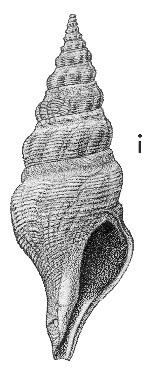
Revised descriptions of New Zealand Cenozoic Mollusca from Beu and Maxwell (1990)

 | Revised descriptions of New Zealand Cenozoic Mollusca from Beu and Maxwell (1990) | 
|
  (Pl. 22i): holotype of Surcula oamarutica Suter, ? Old Rifle Butts, Cape Wanbrow, Oamaru, Altonian (TM6853, GNS) |
Beu & Maxwell (1990): Chapter 11; p. 210; pl. 22 i.
Synonymy: Pleurotoma trailli Hutton 1873b, p. 4 (not of Hutton 1873a); Drillia fusiformis Hutton 1877b, p. 595; Surcula huttoni Suter 1914, p. 28 (new name for P. trailli Hutton 1873b, preoccupied); Surcula oamarutica Suter 1917, p. 51; Turricula oamarutica; Comitas oamarutica
Type species (as Surcula oamarutica) of Comitas Finlay, 1926
Classification: Turridae: "Cochlespirinae" clade 3 or 4 (Puillandre et al. 2008)
Description: Size moderate for genus (height 30-60 mm), fusiform, spire 0.5-0.6 total height. Protoconch mamillate, of about 1.5 smooth whorls, last whorl prominently keeled on some shells, evenly convex on others. Teleoconch of 7-9 whorls, shouldered at or above middle on spire, sutural ramp concave with a low subsutural swelling (more pronounced in some shells than in others), sides strongly convex. Last whorl with rounded periphery, strongly excavated below, neck moderately long, almost straight. Axial sculpture of prominent, opisthocline, rounded costae reaching from lower part of ramp to lower suture on spire, not extending onto base of last whorl; 10-13 costae per whorl. Spiral sculpture rather variable, of weak threads (on a few specimens obsolete) on ramp and considerably stronger cords below, extending over base and neck of last whorl. Aperture pyriform, columella straight or weakly twisted below; siphonal canal moderately long, unnotched. Outer lip thin, anal sinus narrowly U-shaped with apex somewhat above middle of ramp.
Comparison: Comitas fusiformis is very similar to C. onokeana (Mangapanian-Nukumaruan; Recent?), but differs in its rather less slender shape (although shape varies considerably in C. fusiformis), in having less distinctly shouldered teleoconch whorls, and in having more strongly convex whorl sides. Comitas— which is first recorded from the Duntroonian—is one of the most characteristic New Zealand Neogene turrid genera, particularly in mid- to outer shelf and upper bathyal faunules. Powell (1966, p. 29; 1969, p. 262-291) referred numerous Recent Indo-Pacific turrids (mostly of bathyal habitat) to Comitas, but many are probably not congeneric with the New Zealand species. This has been comfirmed by Puillandre et al. (2008), who found Indo-West Pacific Comitas species to be polyphyletic.
Cernohorsky (1987, p. 130) claimed that Comitas fusiformis should be known as C. huttoni, as Surcula huttoni Suter was a replacement name (published before 1961) for the secondary homonym Drillia fusiformis Hutton. However, this is incorrect, as Suter (1914, p. 28) made it quite clear that he was proposing Surcula huttoni for Pleurotoma trailli Hutton, 1873b (June), as it is preoccupied by P. trailli Hutton, 1873a (May). As Drillia fusiformis Hutton, 1877 is a much earlier name for this species than Surcula huttoni Suter, 1914, it is the valid name.
Distribution: Duntroonian-Altonian; Mount Harris Formation, Mt Harris, South Canterbury, Otaian or Altonian (type locality of D. fusiformis); Awamoa, Oamaru, Altonian (type locality of P. trailli); "Oamaru" (probably Old Rifle Butts, Cape Wanbrow, Altonian — type locality of S. oamarutica), and numerous localities in North Otago and Canterbury (including Weka Pass). Particularly common in off-shore siltstone of Mount Harris Formation, less so in the shallower-water Southburn Sand.
Cite this publication as: "A.G. Beu and J.I. Raine (2009). Revised
descriptions of New Zealand Cenozoic Mollusca from Beu and Maxwell (1990). GNS
Science miscellaneous series no. 27."
© GNS Science, 2009
ISBN
978-0-478-19705-1
ISSN 1177-2441
(Included with a PDF facsimile file
copy of New Zealand Geological Survey Paleontological Bulletin 58 in CD version
from: Publications Officer, GNS Science, P.O. Box 30368 Lower Hutt, New
Zealand)